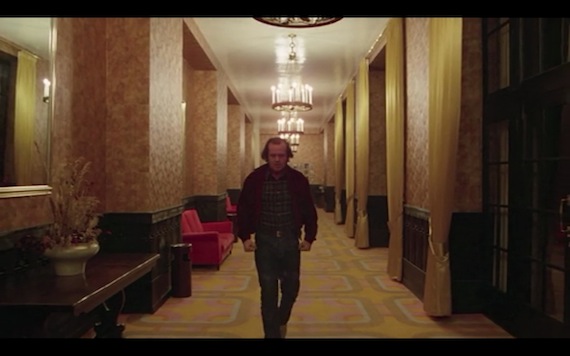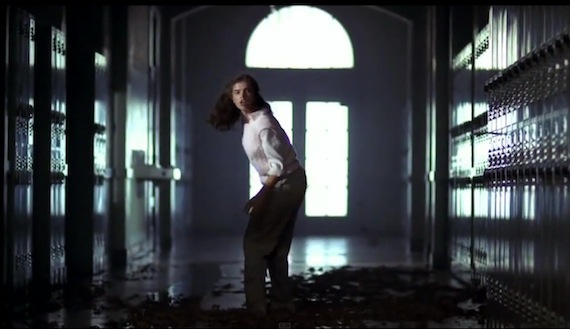“The hallway is my sleep,” writes poet Rafael Campo. Hallways are simultaneously prosaic and oneiric. Hallways are all about perspective.
Jean-Paul Sartre thought modern existence contained a “labyrinth of hallways, doors, and stairways that lead nowhere.” We believe — structurally, metaphorically — that all hallways end. Hallways were not meant for standing, but we adorn them with images. Li-Young Lee’s lines “The photographs whispered to each other / from their frames in the hallway” capture the sense of this place.
I grew up in a ranch house defined by its long central hallway. My bedroom and the living room were on opposite ends of the hall. The New Jersey of my youth was a land of bottleneck traffic, creatively corrupt politicians, and suburbs lined with video rental stores. Whippany, my hometown, was graced with a Movie Van that delivered VHS tapes to doorsteps. The van was a suburban cinephile’s dream, but it didn’t have every horror movie I wanted.
 After I exhausted the late-night timer recordings on my VCR, I began borrowing obscure titles from older friends. I covered my eyes during The Beyond, a particularly gruesome Italian film set in Louisiana. When the movie ended and I turned off the television, I froze. I realized what scared me the most: that long walk down the silent hallway back to my bedroom. My brothers had moved out. My sister was home from college, but was on the phone in her room. My parents had gone to sleep after trying to convince me that I should do the same. I did what any kid with an overactive imagination would: I sprinted down the hallway, shut my door, and dove into bed.
After I exhausted the late-night timer recordings on my VCR, I began borrowing obscure titles from older friends. I covered my eyes during The Beyond, a particularly gruesome Italian film set in Louisiana. When the movie ended and I turned off the television, I froze. I realized what scared me the most: that long walk down the silent hallway back to my bedroom. My brothers had moved out. My sister was home from college, but was on the phone in her room. My parents had gone to sleep after trying to convince me that I should do the same. I did what any kid with an overactive imagination would: I sprinted down the hallway, shut my door, and dove into bed.
When I built up enough nerve to actually finish all of the horror movies I rented or borrowed, it became obvious that hallway scenes are an essential element of American and international horror films. Hallways are tight, narrow, walled, made for transit — and yet sometimes our most sensitive moments are out in the hall, doors closed behind us. Hallways are places for tense encounters, confusion, and fear.
Here are eight essential hallways from horror films.
1. The Shining (1980)
Young Danny Torrence spends much of the film riding his Big Wheel through the hallways of the Overlook Hotel. His hypnotic travels reinforce the idea of the hotel as maze and labyrinth.

A ball rolls along the carpet to Danny, and he looks up, allowing Stanley Kubrick to use the hallway structure as readymade perspective. During the first quarter of the film, viewers are introduced to the layout and grounds of the Overlook as if they were to be also hired as caretakers. Kubrick’s methodical method establishes expectations and curiosities. In our homes, hallways are spaces shared with those we know well; in hotels, hallways are tight byways, places where we share space with strangers.

Jack is a stranger to his wife and son, and possibly to himself — his Vermont teaching backstory is blurry in Kubrick’s treatment. He appears to have been birthed at this hotel, naughty from the start (he is casually reading an issue of Playgirl while waiting to meet with the hotel’s manager). Early in the film, he spends much time in the hotel lobby — typing gibberish for hours, throwing a tennis ball at the wall, starring into a model of the hedge maze — but as the film progresses, Jack is more confined to tight spaces: the Gold Room bathroom, the storeroom, and the hotel’s many hallways.

Dick Hallorann’s long, slow walk seems to get longer and slower with each viewing of the film. The Shining continues past its final reel: a hallway without end.
2. Black Christmas (1974)
The film’s anonymous killer hides in the attic of a sorority house, so he must descend through the upstairs hallway. Near the end of the film, Jess Bradford is alone in the big house, worried as much about the prank-calling killer as she is about her overbearing boyfriend — who is enraged about her decision to get an abortion.

Director Bob Clark, who would revisit this holiday in a lighter fashion within A Christmas Story, plays with hallways and tunnels throughout the film. The police attempt to trace the obscene calls made to the sorority, and the narrative cuts to a technician at the phone company trying to find the origin as he moves through hallways of sound.

3. The House of the Devil (2009)
Viewers of horror films from the ’80s remember the convoluted music interludes that preface the real horror. Think Silent Night, Deadly Night for the right amount of camp. Ti West’s film is a litany of horror homages, but his two-minute dance interlude is quite effective. College student Samantha Hughes spends the night house-sitting for strange owners. An ill, elderly family member rests upstairs, behind a closed door. Bored, Samantha pops a cassette of The Fixx into her Walkman, puts on her headphones, and rocks her way around the house. The song stops when she knocks over a vase in the upstairs hallway.

In a later scene that nods to Rosemary’s Baby, Samantha walks down the hallway, knife in hand. She is not prepared for what happens next.

4. The Exorcist (1974)
Regan MacNeil is sick, and her mother is desperate. She soon enlists the Catholic Church via nearby Georgetown University, where some Jesuits still dabble in that old-time ritual of exorcism. Father Damien Karras, perhaps the most haunted priest to ever appear on film, battles the demon that inhabits Regan. Beaten by the guilt of not caring for his ill mother, Karras limps his way through early attempts to banish the demon.

William Friedkin holds Karras’s pause for a heavy moment. He stands between the domestic world and the supernatural world; are not bedrooms our most mystical spaces — where we love and sleep?
5. Halloween (1978)
I have always found John Carpenter’s film to be so perfectly suburban — violence and mayhem in one house, silence and peace next door.

Exhausted Laurie Strode has stabbed somnambulant killer Michael Myers in the neck. She tells the children she’s been babysitting to get help, and then do — they run out the front door, their screams piercing the suburban silence. Moments later, as Laurie rests in the hallway’s doorframe, Myers rises. A blank-faced Lazarus, Myers is the perfect villain for horror in the home.

6. Rosemary’s Baby (1968)
In the climactic scene, the film’s title character finds that a hidden door in her closet leads to a hallway. Rosemary enters, and immediately faces a painting of a burning church.

Rosemary’s subsequent walk is funereal: her body has been drugged, her heart has been wounded, and her child has been taken. As in Halloween, the threshold between hallway and room becomes a place of union, but the effect is somehow opposite. The satanists in the room first appear banal, urban, engaged in a cocktail chatter, while the hallway Rosemary exited was the infernal place.

Parley Ann Boswell sees Roman Polanski’s work in this film as influential for Kubrick in The Shining: the long hallway “provides a sort of birth canal.” Rosemary is, at the least, reborn to a clearer sense of sight when she exits the hallway.
7. Suspiria (1977)
Dario Argento’s film mixes pulsating images, almost impossible colors, and an overwhelming score by Goblin to create a psychotropic Black Mass.

American dancer Suzy Bannion attends a ballet academy in Freiburg. After leaving practice, Suzy walks down a hallway. She encounters a strange woman and a child who put a spell on her.

Hallways are transformative throughout the film. A red glow paints Suzy as she hopes to discover the evil secret within the school’s labyrinthine corridors.

8. A Nightmare on Elm Street (1984)
The only place that might contain more charged memories than our childhood home is our high school.
Nancy Thompson wakes in class to see the animated corpse of her friend Tina sitting next to her. A student in the front of the room drones lines from Hamlet, the class rapt. Nancy follows Tina’s blood trail to the hallway.


It is best to end with a film about nightmares, because that is how we sometimes encounter hallways. We wake from a bad dream and rub our eyes. Unable to sleep, we walk down the hall, and though we know there is nothing to be afraid of, our fingers trail along the wall, hope for comfort in the dark.









